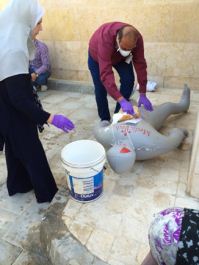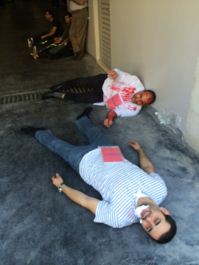 A simulation of a decontamination station 29 September, Amman, Jordan — Since 2013, WHO’s Regional Centre for Environmental Health Action (CEHA) and UK-MED (UKIETR) have been conducting a standardized capacity-building course to train a number of stakeholders throughout the Region on the management of chemical incidents, including hospital management of patients. The training course has been developed as a result of the increasing scale and magnitude of man-made emergencies in the Eastern Mediterranean Region and the need for enhanced guidance and capacity-building of health professionals on preparing for, and responding to, events with public health consequences. This includes provision of solid guidance on exposure to chemical agents that can result in a catastrophic impact on public health.
A simulation of a decontamination station 29 September, Amman, Jordan — Since 2013, WHO’s Regional Centre for Environmental Health Action (CEHA) and UK-MED (UKIETR) have been conducting a standardized capacity-building course to train a number of stakeholders throughout the Region on the management of chemical incidents, including hospital management of patients. The training course has been developed as a result of the increasing scale and magnitude of man-made emergencies in the Eastern Mediterranean Region and the need for enhanced guidance and capacity-building of health professionals on preparing for, and responding to, events with public health consequences. This includes provision of solid guidance on exposure to chemical agents that can result in a catastrophic impact on public health.
Over the past 18 months, the course has been delivered four times in Jordan, for local and international health personnel from the Syrian Arab Republic, Jordan, Lebanon, Iraq, Oman, occupied Palestinian territory, Sudan and Egypt. More than 200 health professionals, decision-makers, as well as environmental health specialists from ministries of health in the Region have been trained during the five rounds of the course. The approach of the course is entirely hands-on in a simulation-based teaching environment. During one round in Dohuk, Iraq, it included a multi-agency drill in which the ambulance services, police and fire brigade participated.
The standardized training package was developed to include a module selector that helped ministries to identify the training modules that best fit the participants taking part. Training has been mainly concentrated on various chemical agents and their potential effects on public health. Chemical incident scene management and coordination between agencies was a strong element of the course.
This latest round of the training was conducted by experts from UKIETR facilitated by CEHA and WHO’s Representative Office in Jordan and Syria. It aimed to deliver interactive, simulation-based training and education focusing on: recognition of chemical, biological, and radiological agent toxdromes; stepwise approach to trauma care in contaminated patients; health worker protection; and the challenges of triage in a contaminated patient.
 Course participants acting during the simulationParticipants evaluation of the course was very positive. On the last day a bomb explosion was simulated in which participants took part.
Course participants acting during the simulationParticipants evaluation of the course was very positive. On the last day a bomb explosion was simulated in which participants took part.
WHO CEHA is currently assessing the interest of other countries in the Region in hosting future rounds of the course.







